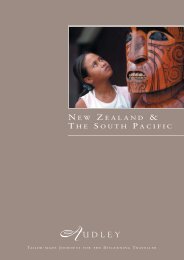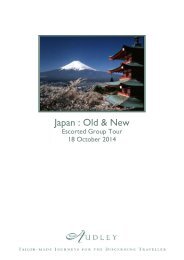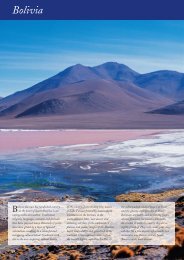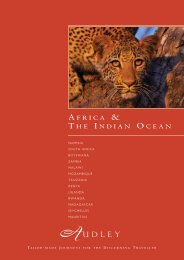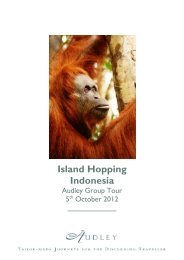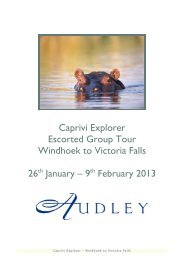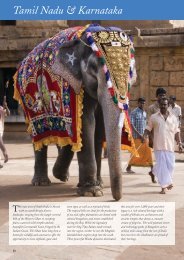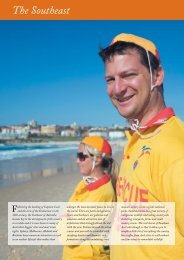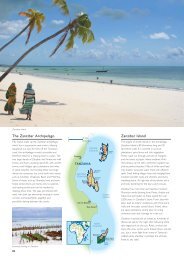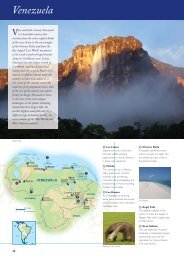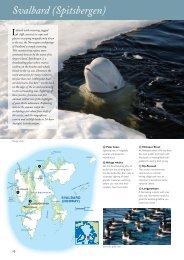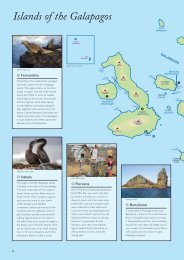01/144 front and back cover.qxd:Audley brochure ... - Audley Travel
01/144 front and back cover.qxd:Audley brochure ... - Audley Travel
01/144 front and back cover.qxd:Audley brochure ... - Audley Travel
You also want an ePaper? Increase the reach of your titles
YUMPU automatically turns print PDFs into web optimized ePapers that Google loves.
ZambiaChattering <strong>and</strong> throwing palmnuts ontothe roof of your cottage, the monkeysstart your day before the sun does. Emerginginto the misty morning, a cup of coffee inh<strong>and</strong>, you watch as the sun rises over abroad snaking river. A breeding herd ofelephant soundlessly descends the dusty bankto drink. The sun turns the glassy waterpink, crocodiles stir <strong>and</strong> a fish eagle’s screechpierces the air. Welcome to Zambia – youhave arrived in the wild heart of Africa.Zambia is the home of the walking safari,<strong>and</strong> its prolific game is especiallyexhilarating when encountered on foot.Elephant, lion, wild dog, spotted hyena,giraffe <strong>and</strong> puku are just some of the gameyou will see. Beware: once you’ve approacheda hundred-strong herd of buffalo on foot,game-viewing from a vehicle may nevergive quite the same thrill. At night there aredrives to search for leopard, the spotlightseeking the reflection of feline eyes in theundergrowth. From the tree-climbing lionsof the Busanga Plains to the hundred-stronghippo pods of the South Luangwa, Zambiais untamed, little-explored <strong>and</strong> as wild asit has ever been.42
<strong>Audley</strong> in Zambia45638712Zambia is one of our favourite countriesin Southern Africa <strong>and</strong> our extensiveknowledge of it comes from many years oftravelling <strong>and</strong> operating safaris in the region.Our chosen camps are small <strong>and</strong> run byfriendly <strong>and</strong> capable Zambians whosewelcome is always warm. They are alsodelightfully close to nature – you might havea vervet monkey on the roof of your b<strong>and</strong>aor a hippo grazing the lodge lawn at night.The country’s main game areas; the LuangwaValley, Lower Zambezi <strong>and</strong> Kafue, are allreached by a good network of flights.<strong>Travel</strong>lers usually spend time in one or twoareas to enjoy the contrasting scenery <strong>and</strong>game. There are several good trip extensionoptions: a few days in Livingstone to see theVictoria Falls, or Lake Malawi is a short flightaway. Zambia is easy to travel around butdon’t let this persuade you that it is a tamecountry – it is one of the wildest insouthern Africa.AccommodationDusk at Busanga Bushcamp1 South LuangwaNational ParkThe home of the walking safari<strong>and</strong> one of the best parks inAfrica for leopard sightings.2North LuangwaNational Park5 Busanga PlainsVast floodplains <strong>and</strong> thecentrepiece of the Kafue. Hometo plains game, tree climbinglions <strong>and</strong> cheetah.6 LivingstoneLivingstone offers beautifulriverside lodges from which tosee the Victoria Falls.7 Shiwa Ng’<strong>and</strong>uAn incongruous stately homebuilt in the remote north byeccentric Englishman StewartGore Browne.African hoopoe8 Bangweulu Wetl<strong>and</strong>sSeasonally flooded grass plainsthat support a rich diversity ofwater birds. Shoebill stork <strong>and</strong>black lechwe are found here.In the national parks, a lodge <strong>and</strong> a h<strong>and</strong>fulof satellite bushcamps are usually owned byone safari operator, often a family business.The lodge will have around six rooms <strong>and</strong> isoften a good place in which to start yoursafari. The satellite bush camps tend to be inremote areas <strong>and</strong> focus on walking safaris.Typically, they have three simple chaletsmade of reed <strong>and</strong> thatch. Overlooking riversor waterholes, the dining room might beunder a sausage tree <strong>and</strong> the open airbathrooms visited by a tree frog or two.All accommodation is unfenced so it’scommon for wildlife to w<strong>and</strong>er throughcamp. Livingstone’s beautiful riverside lodgesare the ideal place in which to start or enda safari; from here you can enjoy VictoriaFalls <strong>and</strong> fall asleep to the sound of hipposgrunting in the water.A wild park with only two camps<strong>and</strong> numerous lion <strong>and</strong> buffalo,excellent for walking safaris.Find out more3 Lower ZambeziNational ParkOne of Africa’s most scenicwildlife areas, concentratedaround the Zambezi River. Thepark supports high densities ofbig game.4 Kafue National ParkA huge wilderness encompassingrivers, picturesque woodl<strong>and</strong> <strong>and</strong>open floodplains.Elephant in the Lower ZambeziFor suggested itineraries <strong>and</strong> practicalinformation about travel in Zambia, pleasesee page 55.☎www.audleytravel.comInteractive maps <strong>and</strong> features,further suggested itineraries,accommodation, climate information<strong>and</strong> articles written by our specialists.Discuss your plans with our Zambiaspecialists <strong>01</strong>993 838 505Zambia 43
Watching elephant on a walking safariSouth Luangwa National ParkThe South Luangwa National Park is tropical, wild<strong>and</strong> beautiful. Situated in a wide rift valley, thepark is flanked by the Muchinga escarpment tothe west <strong>and</strong> the me<strong>and</strong>ering Luangwa River tothe east. Its lush <strong>and</strong> diverse vegetation is hometo a wide variety of game <strong>and</strong> rich birdlife. Muchof the game is found near the river, with herds ofelephant <strong>and</strong> buffalo descending the banks todrink. Large crocodiles laze on s<strong>and</strong>banks <strong>and</strong> atdusk hundreds of hippo leave their pools <strong>and</strong>lumber up the banks to graze. Impala <strong>and</strong> pukuare common <strong>and</strong> Thornicroft’s giraffe can be seenin the forests. Cookson’s wildebeest, Crawshay’szebra, waterbuck, bushbuck, grysbok <strong>and</strong> oribi arealso found. Predators abound, with lion <strong>and</strong>spotted hyena common, while the leopards arealways a highlight. Finally, there are over 400species of bird, with specialities including flocks ofcrowned cranes, colonies of carmine bee-eaters<strong>and</strong> a breeding colony of yellowbilled stork.Walking safaris are a speciality in the Luangwa.Accompanied by guides <strong>and</strong> scouts, walks explorethe riverbanks <strong>and</strong> pretty dambos with theirgreen Nile cabbage <strong>and</strong> crocodiles. There arealso day <strong>and</strong> night drives in open 4x4s.KAPANI LODGE, SOUTHLUANGWA NATIONAL PARKKapani Lodge is a welcoming lodge located in awildlife area adjacent to the South LuangwaNational Park. It has six cottages overlooking apretty lagoon which attracts a wide variety ofgame. With shady gardens, a small pool <strong>and</strong>chattering vervet monkeys, it’s a perfect start toa safari. Walks <strong>and</strong> drives in the park are led byexperienced guides. Kapani works well incombination with a few of its satellite bushcamps(Luwi, Nsolo <strong>and</strong> Kakuli), which are locateddeep within the park.LUWI, NSOLO AND KAKULIBUSHCAMPS, SOUTH LUANGWANATIONAL PARKThese three bushcamps are situated along theLuwi <strong>and</strong> Luangwa rivers <strong>and</strong> you can ramblefrom one to the other on a guided walk. Luwi istiny <strong>and</strong> delightful, with four simple reed roomsunder mahogany trees. Nsolo has beautiful raisedchalets with polished wooden floors <strong>and</strong> openair bathrooms. Finally, Kakuli overlooks theconfluence of the Luwi <strong>and</strong> Luangwa rivers <strong>and</strong>a noisy pod of hippos in the water below.Dining at Nsolo Bushcamp44MCHENJA BUSHCAMP, SOUTHLUANGWA NATIONAL PARKMchenja Bushcamp st<strong>and</strong>s in an ancient ebonygrove – a favourite of baboons – on the banksof the Luangwa. It is one of the most picturesquesites in the park for a camp. There are fourspacious tents, with polished wooden floors, largedecks <strong>and</strong> en suite bathrooms. Activities fromcamp include walking safaris <strong>and</strong> game drives.
Young male lion in the LuangwaWatching puku on a game driveLeopard in the South LuangwaCHAMILANDU BUSHCAMP,SOUTH LUANGWA NATIONAL PARKChamil<strong>and</strong>u is situated in a remote spot on theLuangwa River. The décor of the two-metrehigh tree house chalets is a tasteful blend ofwrought iron <strong>and</strong> brass. Open to a 180° vista,the <strong>front</strong> of each tree house chalet provides theframe for all of the Luangwa Valley’s wildlife, <strong>and</strong>the four poster beds enjoy a bird’s eye view overthe waters of the Luangwa River. A series ofseven ox-bow lagoons around Chamil<strong>and</strong>u yielddiverse habitats <strong>and</strong> attract abundant wildlife.This is a wonderful place to explore both onfoot <strong>and</strong> in 4x4s.KAPAMBA BUSHCAMP, SOUTHLUANGWA NATIONAL PARKKapamba Bushcamp is a beautiful camp withviews over the Kapamba River. There are fourstone <strong>and</strong> thatch chalets, which are open on oneside allowing you to step out into the bush fromyour bedroom. Each chalet has an en suitebathroom with large tub. At night your bathroomis sometimes shared by a couple of small frogs,who will sit <strong>and</strong> watch you clean your teeth!There is a large deck in the centre of camp whereyou can sit <strong>and</strong> enjoy breakfast in the sun <strong>and</strong>campfires in the evening.Chamil<strong>and</strong>u BushcampCHINDENI BUSHCAMP, SOUTHLUANGWA NATIONAL PARKChindeni has one of the most stunning locationsin the South Luangwa, nestled on the apex of apermanent oxbow lagoon in the shadow of themagnificent Nchindeni Hills. Watching thesunrise over the hills in the morning is awonderful way to start the day. Sitting onwooden decking, Chindeni’s four en suite tentshave raised ver<strong>and</strong>as, ideal platforms from whichto view the resident game. Chindeni is only sixkilometres from one of its sister camps,Bilimungwe, so you can enjoy an early morningwalk between the two.KUYENDA BUSHCAMP, SOUTHLUANGWA NATIONAL PARKKuyenda sits on the banks of the Manzi River.The accommodation consists of three rondavelsmade entirely of local material – reed, thatch <strong>and</strong>wood. The chalets are rustic but comfortable <strong>and</strong>offer an authentic bush home. En suite bathroomshave bucket showers <strong>and</strong> guests can order hotwater in advance – this is a true safari experience.Kuyenda is in a good walking area <strong>and</strong> somewalks are guided by Phil Berry, who hasunmatched knowledge of the Luangwa Valley,having spent the last 30 years here.Kapamba Bushcampwww.audleytravel.com/zambia ● <strong>01</strong>993 838 505 ● Zambia 45
Lioness beside the Luangwa RiverTAFIKA CAMP, SOUTH LUANGWANATIONAL PARKTafika Camp st<strong>and</strong>s on high banks above theLuangwa River. Owned by John <strong>and</strong> CarolCoppinger, it prides itself on having some of themost experienced guides in the park. The campitself is comfortable, with five large bungalows.Once across the river, you are in a pristine wildlifearea of the park where there are no roads orother camps, so it is well suited to walking safaris.John owns a microlight <strong>and</strong> will take guests upinto the air at dawn. Skimming low over theLuangwa River <strong>and</strong> watching crocodile splash intothe water is an exhilarating experience. Tafikacombines well with a walking safari to its satellitebushcamps, Chikoko <strong>and</strong> Crocodile.LION CAMP, SOUTH LUANGWANATIONAL PARKLion Camp is located in an area away from othercamps so guests enjoy a private <strong>and</strong> wild safariexperience. The camp overlooks a lagoon <strong>and</strong> isunfenced so it is not unusual for antelope,elephant <strong>and</strong> hippo to w<strong>and</strong>er through the campduring the day. Linked by raised woodenwalkways are nine luxurious canvas <strong>and</strong> thatchchalets. The centre of camp has a large deckwhere dinner is often eaten under the stars. It isone of the few camps in the park to have a smallpool, very welcome in the hot summer months.A chalet at TafikaNKWALI CAMP, SOUTHLUANGWA NATIONAL PARKNkwali Camp is located in an area of ebonywoodl<strong>and</strong> <strong>and</strong> open grass plains. Elephant oftencross the Luangwa River near to the lodge <strong>and</strong>crocodiles can be seen lazing on the s<strong>and</strong>banks.Nkwali has six luxurious chalets overlooking theriver <strong>and</strong> a large bar built around an ebony tree.Dining is often outside under a tree, <strong>and</strong>sometimes on a s<strong>and</strong>bank in the middle of theriver! Nkwali combines well with its sister campsTena Tena <strong>and</strong> Nsefu.Mobile walking safarisZambia is renowned for its walkingsafaris, which were pioneered in theLuangwa Valley. There are two ways toenjoy walking safaris – either on morning<strong>and</strong> afternoon rambles out <strong>and</strong> <strong>back</strong> tothe same camp or on a three or fourday dedicated walking trail.One of our favourite places to start athree day walking trail is Tafika Camp.On a typical trail you would set outfrom Tafika for a morning’s walk througha pristine wilderness area to the firstcamp, Crocodile Camp, only accessibleon foot. A day or so can be spent atCrocodile before taking a morning walkto Chikoko Bushcamp. After a couple ofnights at Chikoko, you can then enjoy awalk <strong>back</strong> to Tafika.The beauty of this trail is that it can betailored to your interests <strong>and</strong> pace,whether you enjoy long or short walks,or a mixture of both. The camps aredelightful with simple reed <strong>and</strong> thatchchalets <strong>and</strong> hot bucket showers. You willdine under sausage trees, shower underthe stars <strong>and</strong> sit around campfires.46The campfire at Lion Camp
Lion prideViewing buffalo on a walking safariCarmine bee-eatersNorth Luangwa National ParkThe North Luangwa is a wild park with virtuallyno roads <strong>and</strong> thus the focus is on walking safaris.The small Mwaleshi River runs through the park,with clear shallow waters <strong>and</strong> low banks, perfectfor rambling along. Game gravitates towards theriver, particularly in the dry season when it iscommon to see buffalo, lion <strong>and</strong> hyena in healthynumbers by the water. There are someparticularly pretty dambos <strong>cover</strong>ed in brilliantNile cabbage with a hippo or two only visible bytheir flickering ears. A short flight from the SouthLuangwa, we recommend adding this park ontothe end of a safari there <strong>and</strong> suggest that youstay at least four days to fully explore thispeaceful wilderness.Walking along the Mwaleshi RiverMWALESHI CAMP, NORTHLUANGWA NATIONAL PARKMwaleshi Camp is one of our favourite camps inAfrica. Taking a maximum of six guests, its reedchalets overlook the Mwaleshi River. Earlymornings <strong>and</strong> evenings are spent walking alongthe banks of the river, looking at everything fromelephant-shrew tracks to lions, determined dungbeetles to exquisite seed pods. In the heat of theday it is possible to paddle in the clear, shallowriver in <strong>front</strong> of camp, which has tiny silver fishbut apparently no crocodiles!Shiwa Ng’<strong>and</strong>u HouseShiwa Ng’<strong>and</strong>uShiwa Ng’<strong>and</strong>u is an old English manorhouse, built deep in the African bush.A flight from the South Luangwa, it isremote but well worth making thejourney for. Perfect avenues ofeucalyptus lead to a graceful statelyhome with sweeping staircases, panelledlibraries, Persian rugs, muskets, chests<strong>and</strong> a clock tower topping the slate tiledroof. Built by Sir Stewart Gore Brownein the early 20th century <strong>and</strong> brought topublic attention by Christina Lamb’sbook ‘The Africa House’, it is steeped inhistory <strong>and</strong> a living memorial to the life<strong>and</strong> work of Sir Stewart. A stay hereamply rewards the intrepid traveller <strong>and</strong>could not provide more of a contrastwith Zambia’s safari camps.Crawshay’s zebraSundown at Mwaleshiwww.audleytravel.com/zambia ● <strong>01</strong>993 838 505 ● Zambia 47
Observing wild dog on a game driveThe Lower ZambeziNational ParkOnce over the Zambezi escarpment, your pilotwill begin to lower the aeroplane <strong>and</strong> the vast riftvalley of the Lower Zambezi will unfold beforeyou, with curving oxbow lagoons <strong>and</strong> the s<strong>and</strong>ywaters of the great Zambezi River. Pods of hippolitter the water, clumped herds of buffalo can beseen on the floodplains, <strong>and</strong> elephant move, earsflapping <strong>and</strong> trunks up, through the trees <strong>and</strong>away from the sound of the plane. With itsfloodplains, grassl<strong>and</strong>s <strong>and</strong> tall forests, the LowerZambezi Valley supports fantastic game densities.Impala are everywhere <strong>and</strong> kudu, el<strong>and</strong>,waterbuck, zebra <strong>and</strong> wildebeest are alsocommon. Elephant are often seen swimming theZambezi River to feed on the grassy isl<strong>and</strong>swhere buffalo graze. The s<strong>and</strong>y river banks arehome to iridescent carmine bee-eater colonieswhile kingfishers <strong>and</strong> African skimmers flit aboveBreakfast at Chongwe River Camp48the waters. Predators include leopard, large pridesof lion <strong>and</strong> packs of wild dog. From walking safaristo drives, boating <strong>and</strong> fishing, the Zambezi has somuch to offer that we recommend a stay of atleast three days to explore it fully.CHONGWE RIVER CAMP,LOWER ZAMBEZI NATIONAL PARKChongwe River Camp is set under a canopy ofwinterthorn acacias on the confluence of theChongwe <strong>and</strong> Zambezi Rivers. The nine tentsall face the river <strong>and</strong> are cool <strong>and</strong> comfortable.A pod of hippos occupy the river in <strong>front</strong> of thelodge <strong>and</strong> crocodiles often laze on the oppositeriverbank alongside storks, herons <strong>and</strong> geese.Activities from camp include game drives, walkingsafaris, boat trips, canoeing <strong>and</strong> tiger fishing.SAUSAGE TREE CAMP,LOWER ZAMBEZI NATIONAL PARKSausage Tree Camp is a luxurious camp perchedon a high s<strong>and</strong>y bank where bee-eaters nest.There are seven stylish tents which have largebeds, antique telephones (the network extendsas far as the bar) <strong>and</strong> open air bathrooms.There is an airy living room with lots of books<strong>and</strong> a dining room where excellent meals areserved. Activities from camp include game drives,walking safaris <strong>and</strong> boat trips <strong>and</strong> Sausage Treealso operates a canoe trail up the Zambezi River.Canoeing by day <strong>and</strong> sleeping on isl<strong>and</strong>s by nightis an exciting way to experience the wildlife.The honeymoon suite at Sausage Tree CampOLD MONDORO, LOWER ZAMBEZINATIONAL PARKOld Mondoro is small <strong>and</strong> simple, surrounded bygood walking country, making it the ideal campfrom which to enjoy walks as well as game drives.There are four chalets with double beds, en suitebathrooms <strong>and</strong> timber decks outside. At night,lanterns lead from the chalets to the dining room,where you can sit around the fire <strong>and</strong> discuss theday’s events. Set deep in the park, the camp issurrounded by excellent game densities, makingdrives, walks <strong>and</strong> boat trips very rewarding.Old Mondoro
Waterbuck in Mana Pools National ParkYoung leopardCanoe safari in Mana PoolsThe pool at Rukomechi CampMana Pools, ZimbabweDirectly across the river from the Lower ZambeziNational Park is Mana Pools in Zimbabwe.Reached by a three hour road <strong>and</strong> boat transferfrom Lusaka or via a short flight, this is a greatalternative to a safari in the Lower Zambezi. In itsheyday, Mana was one of the most sought after<strong>and</strong> exclusive parks in Zimbabwe, <strong>and</strong> as fewvisitors have travelled there in the last ten years,the park remains unchanged. The presence ofscouts <strong>and</strong> rangers has meant that it has beenunaffected by poaching, <strong>and</strong> game densities areas high as they’ve ever been. Visitors are nowreturning to the park, accessing it from theZambian side <strong>and</strong> enjoying one of SouthernAfrica’s premier wildlife destinations, with theadded bonus of having to share it with fewother visitors.Mana Pools <strong>cover</strong>s 2,000 square kilometres oftotal wilderness, much of it with no roads, so it isideal for exploration on foot. This stretch of theZambezi River is famous for its four pools: Main,Chine, Long <strong>and</strong> Chisambuk, which are remnantsof channels of the river which stopped flowingyears ago. These, <strong>and</strong> smaller seasonal poolsdotted further inl<strong>and</strong>, hold water all year round,drawing a wide variety of game. The area isrenowned for having large numbers of elephant,buffalo, hippo <strong>and</strong> el<strong>and</strong>. Predators such as lion,leopard <strong>and</strong> wild dog are regularly sighted <strong>and</strong> thebirdlife is superb. There are only a couple of smallcamps in the park as well as a number of guidedcanoe trails. It is an excellent addition to a trip toZambia <strong>and</strong> suited to those looking for a puresafari experience.Tents on a Mana canoe trailRukomechi CampRUCKOMECHI CAMP,MANA POOLSRuckomechi Camp sits in a grove of acacia <strong>and</strong>mahogany trees on the banks of the ZambeziRiver. There are ten spacious tents, all withdouble or twin beds <strong>and</strong> en suite bathrooms withhot showers. The central dining <strong>and</strong> lounge areasface the Zambezi escarpment <strong>and</strong> a separatedeck has an infinity pool for the hot afternoons<strong>and</strong> a cushion-strewn star gazing deck for night.Activities from the camp include game drives,boat trips <strong>and</strong> walking safaris, although it is oftenunnecessary to leave the camp to see game, aselephant frequently w<strong>and</strong>er in to snack on thefruit of the albida trees.MANA CANOE TRAIL,MANA POOLSThis three night canoe trail explores one of themost beautiful stretches of the Zambezi River.The whole trail <strong>cover</strong>s a distance of 65kilometres, <strong>and</strong> each day you’ll canoe a stretchof river before stopping for lunch on an isl<strong>and</strong>or s<strong>and</strong>bank. There is the chance to explore thepark on foot in the afternoon before campingeach night on the banks of the river. The trail isled by an experienced guide <strong>and</strong> support vehicles<strong>and</strong> staff set up camp each day on your arrival.It is an ideal trip for the fit <strong>and</strong> adventuroustraveller who wants to encounter wildlife fromclose quarters.www.audleytravel.com/zambia ● <strong>01</strong>993 838 505 ● Zambia 49
Dawn on the Busanga Plainszebra, Lichtenstein’s hartebeest, blue wildebeest,oribi <strong>and</strong> sable antelope. Cheetah stalk throughthe stubbly grass <strong>and</strong> prides of lion relax alongthe branches of fig trees. With clouds of openbilled storks overhead, you are surrounded bywildlife. This variety of environments can beexplored on walking safaris, boat trips <strong>and</strong> day<strong>and</strong> night game drives.Lufupa River LodgeThe Kafue National ParkAt over 22,000 square kilometres, the KafueNational Park is a huge magical wilderness. It hastropical rivers filled with hippo, vast floodplainswith herds of grazers, <strong>and</strong> twisted fig trees amongwhose branches lions are found. With fewvisitors, it is wild <strong>and</strong> untamed. In the north, theLufupa <strong>and</strong> Lunga Rivers twist <strong>and</strong> turn, <strong>and</strong>boating along these you will see the corrugated<strong>back</strong>s of crocodiles gliding silently underoverhanging trees. Elephant come to the smalls<strong>and</strong>y beaches to drink along with bushbuck,defassa waterbuck, el<strong>and</strong> <strong>and</strong> more. Deep in thepark, the Busanga Plains are a highlight. Seasonalfloodplains, these immense grassl<strong>and</strong>s are onlyaccessible from June to October. Here the newshoots attract large herds of puku, red lechwe,LUFUPA RIVER LODGE, KAFUENATIONAL PARKSituated on the banks of the Lunga River, thissmall lodge is welcoming <strong>and</strong> comfortable withtwelve canvas chalets looking out onto the water.There’s a small pool <strong>and</strong> bar deck on stiltsabove the water – perfect for sundowners inthe warm evenings. Lufupa offers a variety ofactivities including boat trips, walks, <strong>and</strong> day <strong>and</strong>night drives.BUSANGA BUSHCAMP, KAFUENATIONAL PARKBusanga Bushcamp sits on a fig tree isl<strong>and</strong> on theBusanga Plains. The four tented rooms have gauzenetting walls permitting fabulous views over thePlains. There are en suite open air bathroomswhich allow you to shower either with the sunbeating down on your <strong>back</strong> or under the stars.Dining is under canvas <strong>and</strong> there’s always acampfire in the evenings. Activities focus on day<strong>and</strong> night drives on the Busanga Plains as well ashot air ballooning.Hot air ballooning over the Busanga PlainsHot air ballooningA fascinating way to experience theBusanga Plains is from the basket of a hotair balloon. You will take off before dawn<strong>and</strong> rise up into the air with the sun.The balloon will float where the windtakes it – over grassl<strong>and</strong>s, fig tree isl<strong>and</strong>s,rivers <strong>and</strong> wetl<strong>and</strong>s. Wildlife looksdifferent when viewed from above –you can see birds roosting at the tops oftrees, the patterns of herds on the plains<strong>and</strong> the <strong>back</strong>s of hippos <strong>and</strong> crocodiles inthe water. Accompanied by the mist thatoften rises off the plains in the earlymorning, these trips are visually stunning<strong>and</strong> excellent for keen photographers.On l<strong>and</strong>ing, a champagne breakfast isserved before a leisurely game drive<strong>back</strong> to camp.50
Zambia’s safari housesElephant in <strong>front</strong> of the Luangwa HouseThe concept of the safari house, now popularacross Africa, was pioneered in Zambia. Thecountry has a number of beautiful houses, allbuilt in the middle of the bush, with spaciousliving areas, characterful bedrooms <strong>and</strong>luxurious bathrooms. On stepping out throughthe <strong>front</strong> door, however, you might encounterpuku on the lawn or an elephant drinking fromthe swimming pool.These luxurious houses are booked exclusively<strong>and</strong> are ideal for small groups. Luangwa House<strong>and</strong> Robin’s House are located in the heart ofthe South Luangwa. Chongwe River House<strong>and</strong> Kigelia House are located in the LowerZambezi <strong>and</strong> Tangala House is close toLivingstone, on the banks of the Zambezi River<strong>and</strong> near a rather noisy pod of hippos.The safari houses are ideal for families,which the Zambians welcome with open arms.The houses come complete with guides <strong>and</strong>activities that can be tailored to each specificfamily. Game drives can be enjoyed byparents <strong>and</strong> children together, or the childrencan enjoy their own special safari programme.There is a range of activities for young guests,from walking out to collect seed pods totracking lessons. For younger children, thekitchen <strong>and</strong> gardens are a highlight <strong>and</strong> theycan bake cookies, collect hens’ eggs <strong>and</strong>pick pineapples.Chongwe River HouseCHONGWE RIVER HOUSE,LOWER ZAMBEZI NATIONAL PARKChongwe River House has a secluded settingon the banks of the Chongwe River. The househas furniture made from winterhorn trees <strong>and</strong>its ceiling contains pebbles from the ChongweRiver. The four bedrooms have spectacularviews, <strong>and</strong> the en suite bathrooms have tapscarved from bone. Outside there is a smallpool <strong>and</strong> the lawn is ideal for al fresco dining.LUANGWA HOUSE, SOUTHLUANGWA NATIONAL PARKThe Luangwa House overlooks a seasonallagoon, frequented by elephant <strong>and</strong> giraffe. It isbuilt with ancient leadwood trees, stone <strong>and</strong>thatch. There are four bedrooms, two upstairs<strong>and</strong> two downstairs. The centre of the house isdominated by a stunning open plan living roomwith views out to the waterhole. Outside thereis a plunge pool <strong>and</strong> a walkway out to aviewing deck above the waterhole. In the dryseason this is a particularly exciting place to sit,as herds of elephant come to drink.ROBIN’S HOUSE, SOUTHLUANGWA NATIONAL PARKRobin’s House is situated on the banks of theLuangwa River <strong>and</strong> shaded by ebony trees.Stone steps lead up into a cool central livingroom with squashy sofas <strong>and</strong> views of theriver. The living room has two bedroomsleading off it, each with an en suite bathroomwith shower <strong>and</strong> bathtub. A short walk awayfrom the house there is a pool that is sharedwith nearby Nkwali Camp. The house comeswith its own staff, including a private chef<strong>and</strong> a guide.Robin’s HouseA bedroom in Luangwa Housewww.audleytravel.com/zambia ● <strong>01</strong>993 838 505 ● Zambia 51
Victoria FallsLivingstone & Victoria FallsOne of the natural wonders of the world,Victoria Falls is known as the ‘smoke thatthunders’ in the local language. It is an apt namegiven the thundering roar that resounds as thesparkling Zambezi River pours great cascades ofwhite water over the lip of the Falls. Walkingalong little paths to view this phenomenon ofnature, you see trumpeter hornbills dart out fromdripping trees to fly across the water. Vervetmonkeys <strong>and</strong> baboons chatter <strong>and</strong> a rainbowforms across the spray when the sun comes out.There are excellent views from the Zambian side,where you can also cross Knife Edge Bridge to anisl<strong>and</strong> surrounded by water. Ten kilometres fromthe Victoria Falls, Livingstone town has sprung tolife with lots of small guesthouses, lively markets<strong>and</strong> operators offering every possible activityfrom helicopter rides to exhilarating whitewaterrafting trips <strong>and</strong> gentle boat cruises on theZambezi. We recommend staying outside theA chalet at Waterberry52town in one of the quiet lodges on the ZambeziRiver, from where you can visit the Victoria Fallsas well as go on sunset boat trips, walks <strong>and</strong> visitsto village markets.TONGABEZI LODGE & SINDABEZIISLAND CAMP, LIVINGSTONETongabezi is situated on the banks of the ZambeziRiver. Rooms are large with polished stone floors,cream fabrics <strong>and</strong> en suite bathrooms withVictorian baths <strong>and</strong> shining brass taps. There’s apool built into the rocks <strong>and</strong> sunloungers in theshade. Tongabezi combines well with a stay at itssister camp, Sindabezi. Sitting on a little isl<strong>and</strong> inthe middle of the river, Sindabezi is a tranquil spotwith white <strong>front</strong>ed bee-eaters flitting from thetrees. The rooms are luxurious <strong>and</strong> the welcomewarm – it is one of our favourite camps in Zambia.WATERBERRY ZAMBEZI LODGE,LIVINGSTONEThis pretty lodge is located on the banks ofthe Zambezi about 45 minutes’ drive fromthe Victoria Falls. There are seven thatchedcottages overlooking either the river or gardens.A split-level main building houses a dining <strong>and</strong>lounge area <strong>and</strong> looks over the water. A greatplace to relax, Waterberry also offers a range ofactivities including a guided trip to the VictoriaFalls, a sunset cruise on the river, <strong>and</strong> a particularlyinteresting visit to a nearby village with one ofthe local staff.A room at Sindabezi Isl<strong>and</strong> CampTOKA LEYA, LIVINGSTONEToka Leya has 15 canvas rooms on the banks ofthe Zambezi River. All rooms are connected bywooden walkways, allowing game to pass throughthe camp uninterrupted. The main lodgecomprises of an open sided lounge withcomfortable sofas <strong>and</strong> tables for private orcommunal dining. The bar has views onto theriver, <strong>and</strong> there is a shady deck where you canenjoy lunch. The pool <strong>and</strong> small spa make thisan ideal place to relax before or after a safari.Toka Leya
The Victoria Falls Hotel, Victoria Falls TownMalachite kingfisherVictoria Falls Town,ZimbabweThe small town of Victoria Falls in Zimbabwe isless than two kilometres south of the ZambeziRiver <strong>and</strong> the border to Zambia. UntilZimbabwe’s political problems surfaced, it wasthe place to stay to see the waterfalls <strong>and</strong> thetown was buzzing <strong>and</strong> vibrant. Whilst the pastfew years saw troubled times for the country,Victoria Falls Town was one of the few areasthat managed to retain a semblance of a tourismindustry. Recently the town has begun to cometo life again with hotels receiving refurbishments<strong>and</strong> new restaurants opening. The streets arenow busy <strong>and</strong> everything from washing powderto wooden curios is readily available. The townhas a number of hotels, including the famousVictoria Falls Hotel which was always, <strong>and</strong> still is,the place to have tea on the terrace. You canwalk to the Falls from many of the hotels <strong>and</strong>enjoy a leisurely morning exploring the rainforestpathways with the <strong>back</strong>drop of chatteringmonkeys. Easily reached from the parks inZambia, Zimbabwe <strong>and</strong> Botswana, Victoria FallsTown is once again, a wonderful start or endto any safari.Dining at the Victoria Falls Safari LodgeTHE VICTORIA FALLS HOTEL,VICTORIA FALLS TOWNThis historic hotel overlooks the Victoria FallsBridge <strong>and</strong> the gorges below. Situated in acresof private garden, the charm <strong>and</strong> tranquilatmosphere has long been a favourite withvisitors. A walk along the hotel’s pathway willbring guests out at the top of the gorge <strong>and</strong>provides views of the bridge. With colonialprints <strong>and</strong> antique furniture, history surroundsyou at every turn. The colonial heritage extendsinto the 184 rooms <strong>and</strong> suites which all havefour-poster or canopy beds. The hotel’s famousStanley’s Terrace is the place to enjoy afternoontea watching the spray rise up from the water.ILALA LODGE, VICTORIAFALLS TOWNIlala Lodge enjoys a secluded location close totown. It is the nearest lodge to the Falls <strong>and</strong> fromthe gardens you can hear the roar of the water.The lodge borders the Victoria Falls National Park<strong>and</strong> it is common to see wildlife w<strong>and</strong>ering acrossthe lawn. A wide ver<strong>and</strong>ah wraps round the <strong>front</strong>of the hotel providing a shady area where youcan relax <strong>and</strong> look out across the pretty gardens.There are 32 en suite rooms, a pool with athatched bar area <strong>and</strong> a good restaurant that ispopular with hotel residents <strong>and</strong> locals alike.VICTORIA FALLS SAFARI LODGE,VICTORIA FALLS TOWNThe Victoria Falls Safari Lodge is set high on aplateau, four kilometres from town. The plateauforms a natural boundary to the unfencedZambezi National Park <strong>and</strong> there are fantasticuninterrupted views from the hotel. A waterholein <strong>front</strong> of the lodge attracts a variety of gameduring the dry season, including elephants,buffalo, impala <strong>and</strong> kudu. With the feel of alarge safari lodge there are 72 en suite roomswith hardwoods, thatch <strong>and</strong> vibrant colours, allfacing across the park. As well as visits to theFalls you can enjoy guided bushwalks on thesurrounding reserve.Ilala Lodge, Victoria Falls Townwww.audleytravel.com/zambia ● <strong>01</strong>993 838 505 ● Zambia 53
Zambia’s Green SeasonLuangwa in the Green SeasonYoung impalaIn Zambia’s Luangwa Valley, the time fromNovember to May is known as the GreenSeason. Heavy rains arrive, promoting lushgrowth that sparkles green under hot skies.Plains are carpeted with tall grasses <strong>and</strong> thel<strong>and</strong> is flushed with thickets <strong>and</strong> forests in fullfoliage. The rains are welcomed by the localsas it is good for the surrounding farms. Daysare beautiful <strong>and</strong> warm between showers,many of which occur in the afternoons or atnight. With the downpour of rain the LuangwaRiver swells <strong>and</strong> bursts its banks, floodinglagoons which fill with hundreds of waterbirds.Herbivores give birth <strong>and</strong> birds are in breedingplumage. The only creature that is notablefor its absence is the visitor. With parks emptyof vehicles <strong>and</strong> prices a fraction of those inhigh season, this is a magical time for thesafari enthusiast.Wildlife in the Green SeasonIn the Green Season you will not see thegreat numbers of game congregated at watersources that you would in the dry season.However, the rains bring abundant food <strong>and</strong>many animals give birth. There are nurseriesof tiny impala tottering around on wobbly legs<strong>and</strong> baby warthogs sprinting to burrows.Proliferation of vulnerable animals brings aboutincreased predator activity <strong>and</strong> sightings can beextraordinary. In early May packs of wild dogsare seen. Birding is exceptional with an influxof migratory birds arriving in the valley. Spiralsof migrating storks fill the air, heronries areformed <strong>and</strong> colonies of weavers’ nests hangover lagoons. Birds adopt colourful breedingplumage <strong>and</strong> mating displays are common.Safaris in the Green SeasonBecause of water levels, fewer camps areopen during the Green Season. Those thatdo remain open include Kapani Lodge, KakuliBushcamp, Nkwali, Nsefu, Mfuwe Lodge <strong>and</strong>Kapamba Bushcamp. These camps have agood network of all-weather roads makinggame drives possible. In addition to gamedrives many camps offer boat trips on theLuangwa River. As visitor numbers are low,you can often enjoy private guiding fromsome of Zambia’s top guides.Special interest safarisThe Green Season lends itself to a number ofspecialist safaris. It is an excellent time of yearfor photographers as there is less dust <strong>and</strong> theair is crystal clear. The skies begin the day bluebefore building up in the afternoon withspectacular clouds <strong>and</strong> light. Two photographicworkshops are run in the South Luangwaallowing amateur photographers to improvetheir skills. Two migrations arrive in Zambiaat this time; blue wildebeest to the Liuwa plainin early November <strong>and</strong> ten million bats toKasanka in late November. Mobile safaris runto each migration. Finally, around early Maytwo wild dog safaris are run in the Luangwato see these endangered animals.Masked weaver displaying54
Suggested itinerariesTailoring your tripThe itineraries shown are designed to give you aflavour of what is possible, <strong>and</strong> are routes thatwork particularly well. We can use these as abasis to plan your trip or can design a completelydifferent itinerary to suit your tastes <strong>and</strong> interests.DEMOCRATIC REPUBLICOF CONGOZAMBIASouth LuangwaNational ParkDEMOCRATIC REPUBLICOF CONGOZAMBIASouth LuangwaNational ParkPlease call one of our Zambia specialists to startplanning your itinerary.Telephone: <strong>01</strong>993 838 505LusakaLusakaLower ZambeziNational ParkGetting aroundLivingstoneZIMBABWEZIMBABWEZambia’s four main game areas are the KafueNational Park, Lower Zambezi National Park <strong>and</strong>the North <strong>and</strong> South Luangwa Parks. Distancesbetween the parks are large <strong>and</strong> roads poor. Forthis reason we will fly you from one to the other,using a network of light aircraft flights. On arrivalat the airstrip you will be met by your guide withan open 4x4 <strong>and</strong> taken to your first camp. Atypical itinerary will usually incorporate a numberof camps in one park. <strong>Travel</strong>ling from one to theother can either be done by game drive or onfoot, as many of Zambia’s camps are deliberatelyspaced at walking distance apart.When to goJan Feb Mar Apr May Jun Jul Aug Sep Oct Nov Dec✓ ✓ ✓ ✓ ✓ ✓✓ ✓✓ ✓✓ ✓✓ ✓✓ ✓ ✓✓✓ The best time to travel.✓ A good time to travel, but there may be some factors to be aware of.~ <strong>Travel</strong> is possible, but this is not the best time of year.✕ <strong>Travel</strong> is not recommended.Zambia is situated in the tropics <strong>and</strong> receivesstrong sunlight <strong>and</strong> good rainfall. Its seasons canbroadly be divided into two periods, the dryseason which runs from May to the end ofOctober <strong>and</strong> the green season which run fromNovember to April. In the dry season you canexpect clear blue skies <strong>and</strong> sunshine. The monthsof July <strong>and</strong> August can be cold at night but arehot during the day. As the dry season progressesthe temperature rises with September <strong>and</strong>October seeing temperatures of over 30°C. FromNovember onwards, Zambia receives high rainfall.This leads to many areas becoming inaccessible<strong>and</strong> the camps in the Kafue <strong>and</strong> Lower Zambeziclose. Some camps in the South Luangwa stayopen <strong>and</strong> offer good boat safaris. The vegetationexplodes, animals give birth <strong>and</strong> bird numbersswell with an influx of migrants.Time difference: GMT+2 hoursFlight time from UK: 10 hoursPricesWe offer trips to cater for a wide range ofbudgets. You can find up-to-date guideline pricesfor your trip to Zambia on our website,alternatively please call our specialists to discussyour plans.Classic ZambiaThis itinerary combines a stay on an isl<strong>and</strong> nearto the Victoria Falls with a week on a wild safariin the South Luangwa National Park. On tinySindabezi Isl<strong>and</strong>, in the middle of the ZambeziRiver, you can relax <strong>and</strong> enjoy boat trips on theriver. A spectacular flight across Zambia takes youto the heart of the South Luangwa National Park.Here we’ve chosen a series of small camps in aremote area of the park. You can spend your daysgame viewing from open vehicles or on foot, <strong>and</strong>as darkness falls, there is the chance to search forleopard, honey badgers, bushbabies <strong>and</strong>porcupines on a night drive.Day 1Days 2-4Days 5-7Days 8-9Fly from the UK to Livingstonevia Johannesburg.Arrive in Livingstone for three nightsat Sindabezi Isl<strong>and</strong> Camp. Explore theVictoria Falls, visit local village <strong>and</strong>take boat trips on the Zambezi River.Fly to the South Luangwa for threenights at Chamil<strong>and</strong>u Bushcamp.Enjoy game drives, night drives <strong>and</strong>walking safaris.Walk or game drive fromChamil<strong>and</strong>u to Chindeni Bushcamp.Further time on safari.Days 10-11 Game drive to Kapamba Bushcampfor two nights. Further time on safari.Day 12Day 13Stay longerGame drive from Kapamba to theairstrip. Fly to Lusaka for one night.Fly from Lusaka to the UK. Arrive<strong>back</strong> in the UK in the early evening.The South Luangwa combines easily with a beachstay on Lake Malawi. A light aircraft flight takes youstraight into Lilongwe from where you can drive orfly onwards to the lake. We recommend stayingon colourful Likoma Isl<strong>and</strong>, with its small fishing<strong>and</strong> farming villages <strong>and</strong> easy pace of life. With notraffic, the roads are ideal for cycling <strong>and</strong> there isplenty to see, from the golden beaches to theimpressive cathedral on the centre of the isl<strong>and</strong>.Stay a week or so at Kaya Mawa, an idyllicproperty perched up on rocks above crystal clearwaters, <strong>and</strong> spend your days relaxing beside thepool, on the beach, snorkelling, sailing <strong>and</strong> diving.Luangwa & LowerZambezi ExplorerThis itinerary uses three camps with primelocations in their respective parks. Combining theLuangwa <strong>and</strong> Lower Zambezi provides a goodcontrast in scenery, activities <strong>and</strong> game <strong>and</strong> gives arounded safari experience. Starting in the Luangwaat Kakuli Bushcamp you can enjoy day <strong>and</strong> nightgame drives before walking along the river toyour next camp, Muchenja. After time here, aspectacular flight over the Zambezi escarpmentbrings you to the Lower Zambezi. As well as day<strong>and</strong> night game drives <strong>and</strong> walking safaris, theLower Zambezi is particularly good for boat trips.Day 1Days 2-4Days 5-7Days 8-11Day 12Stay longerFly from the UK to Lusaka.Arrive in Lusaka <strong>and</strong> connect witha flight to the South Luangwa fortwo nights at Kakuli Bushcamp.Enjoy game drives, night drives <strong>and</strong>walking safaris.Walk or game drive to MchenjaBushcamp for two nights. Furthertime on safari.Game drive to the airstrip. Fly to theLower Zambezi for four nights atSausage Tree Camp. Enjoy gamedrives, night drives, walking safaris<strong>and</strong> boat trips on the Zambezi River.Fly to Lusaka <strong>and</strong> on to the UK.Arrive <strong>back</strong> in the UK in the evening.Complete the safari with a trip to the KafueNational Park. This spectacular wildlife area hasfew camps <strong>and</strong> is wild <strong>and</strong> unexplored. FromLufupa Lodge enjoy boat trips, walking safaris <strong>and</strong>game drives. Then, take a trip up to the BusangaPlains to stay in Busanga Bushcamp <strong>and</strong> take tothe air in a hot air balloon.Viewing hippo on a walking safariwww.audleytravel.com/zambia ● <strong>01</strong>993 838 505 ● Zambia 55 53



